
The Salsoloideae are a subfamily of the Amaranthaceae, formerly in family Chenopodiaceae.

Conopholis americana, the American cancer-root, bumeh or bear corn, is a perennial, non-photosynthesizing parasitic plant. It is from the family Orobanchaceae and more recently from the genus Conopholis but also listed as Orobanche, native but not endemic to North America. When blooming, it resembles a pine cone or cob of corn growing from the roots of mostly oak and beech trees.
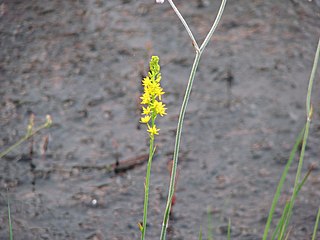
Narthecium americanum is a species of flowering plant in the Nartheciaceae known by the common names yellow asphodel and bog asphodel. It is native to New Jersey in the United States. It is now apparently limited to that state, having likely been extirpated from Delaware, North Carolina, and South Carolina.
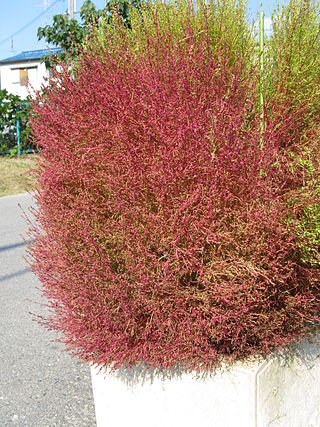
Kochia is a synonym of the genus Bassia, which belongs to the subfamily Camphorosmoideae of family Amaranthaceae.
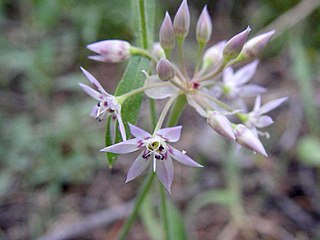
Allium campanulatum is a species of wild onion known by the common name dusky onion or Sierra onion. This is a flowering plant native to the western United States from southeastern Washington and northern Oregon to southern California, and western Nevada. The dusky onion grows in foothills and mountains, especially in dry areas, such as chaparral habitats.
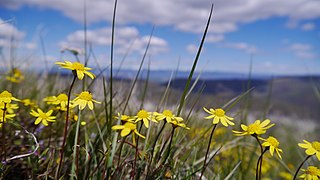
Crocidium multicaule is a species of flowering plant in the daisy family known by the common name spring gold.

Corylus americana, the American hazelnut or American hazel, is a species of deciduous shrub in the genus Corylus, native to the eastern and central United States and extreme southern parts of eastern and central Canada.

Arabis lemmonii is a species of flowering plant in the family Brassicaceae known by the common name Lemmon's rockcress. It is native to western North America from Alaska to California to Colorado, where it grows in a number of rocky habitat types.
Neokochia californica is a species of flowering plant in the subfamily Camphorosmoideae of the amaranth family known by the common name rusty molly. It is native to the valleys and deserts of southeastern California and adjacent parts of Nevada, where it grows in dry, alkaline soils such as alkali flats and desert washes. This is a perennial herb or small shrub growing one or more sprawling, branching stems to a maximum height near 60 centimeters. The stems are lined with narrow, elongated, somewhat flattened fleshy leaves up to about a centimeter long. The leaves and stem are coated in grayish or brownish hairs. The inflorescence is made up of one or more tiny hairy flowers sprouting from the axils of the leaves.

Saussurea americana is a species of flowering plant in the family Asteraceae in the genus Saussurea known by the common name American saw-wort. It is native to northwestern North America from Alaska to far northern California to Montana, where it grows in mountain habitat, such as meadows and forests.

Setaria verticillata is a species of grass known by the common names hooked bristlegrass, rough bristle-grass and bristly foxtail. It is native to Europe, but it is known on most continents as an introduced species and often a noxious weed. It is a hardy bunchgrass which grows in many types of urban, cultivated, and disturbed habitat. It is a weed of many types of agricultural crops, growing in vineyards and fields. Herbicide-resistant strains have been noted.

Camphorosmeae is a species-rich tribe of the Amaranthaceae, formerly Chenopodiaceae, with 20 genera and about 179 species. It is classified as a single tribe of subfamily Camphorosmoideae.

Eriocaulon parkeri is a species of flowering plant in the pipewort family known by the common names Parker's pipewort and estuary pipewort. It is native to eastern North America, where its distribution spans the coast from Quebec to North Carolina. It is extirpated from New York and Pennsylvania, however.
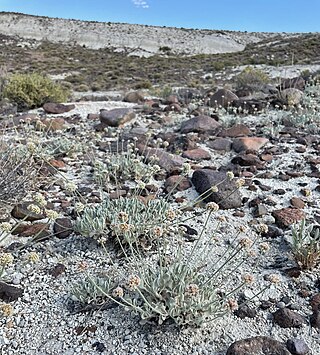
Eriogonum diatomaceum is a species of wild buckwheat known by the common name Churchill Narrows buckwheat. It is endemic to Nevada in the United States, where it is known only from the Pine Nut Mountains in Lyon County. It is limited to the Churchill Narrows near Fort Churchill State Historic Park. This plant was discovered in 1997 and described to science in 2002.
Matelea alabamensis is a species of flowering plant in the dogbane family known by the common names Alabama milkvine, Alabama anglepod, and Alabama spiny-pod. It is native to the southeastern United States, where it occurs in Alabama, Georgia, and Florida.

Solidago ouachitensis is a North American species of flowering plants in the family Asteraceae known by the common name Ouachita Mountain goldenrod. It has a very limited range, found only in the Ouachita Mountains along the border between Arkansas and Oklahoma in the United States.

Crocidium is a small North American genus of plants in the daisy family. Crocidium is native to western North America: British Columbia Washington, Idaho, Oregon, and California.

Erigeron radicatus is a North American species of flowering plant in the family Asteraceae known by the common names Hooker's fleabane and taproot fleabane The species grows in central Canada and parts of the north-central United States, primarily the northern Rocky Mountains and the Black Hills. It has been found in Idaho, Montana, Utah, Wyoming, Colorado, Nebraska, and South Dakota, with a few isolated populations reported from North Dakota.

Smelowskia americana is a species of Smelowskia known by the common names alpine smelowskia, Siberian smelowskia, and American false candytuft. Native to mountain ranges of western North America including the Olympic Mountains and Cascade Range of Washington and the Rocky Mountains of British Columbia and Alberta south to Colorado, it occurs on rocky outcrops and talus at subalpine and alpine elevations, i.e., from 1,300–4,000 metres (4,300–13,100 ft), and blooms from late May until early September.
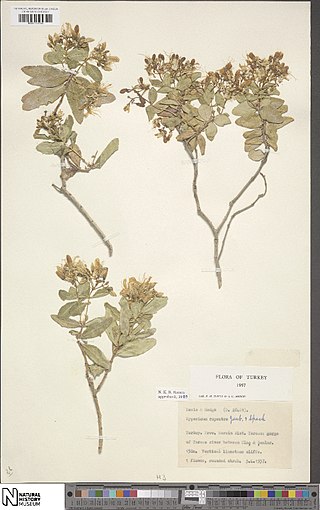
Hypericum rupestre is a species of flowering plant in the genus Hypericum. It is the type species of sect. Arthrophyllum. It was first described by Hippolyte Jaubert and Édouard Spach in 1842 in the journal Ill. Pl. Orient.. The species is found only in a small area in the southern region of Turkey.

















